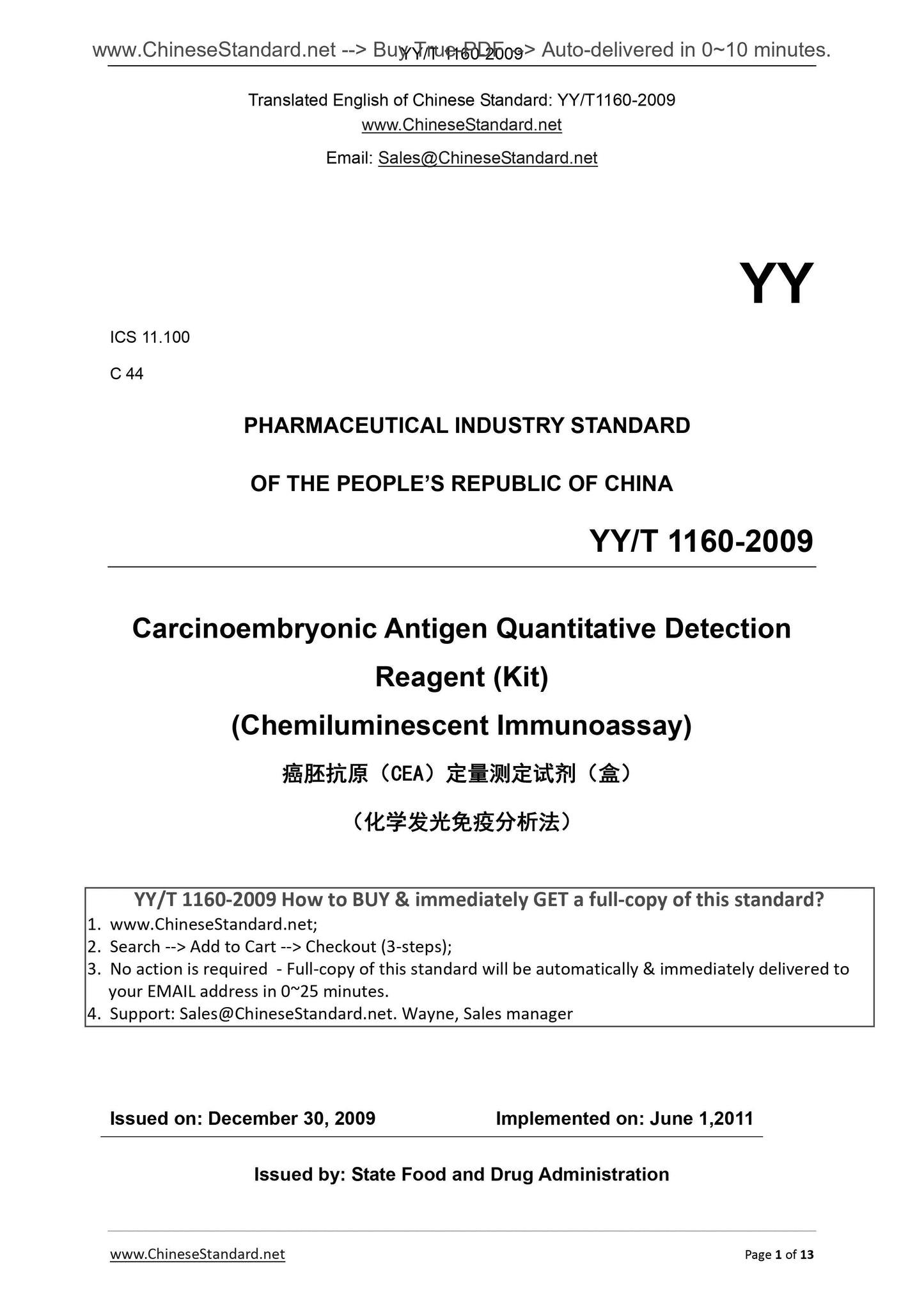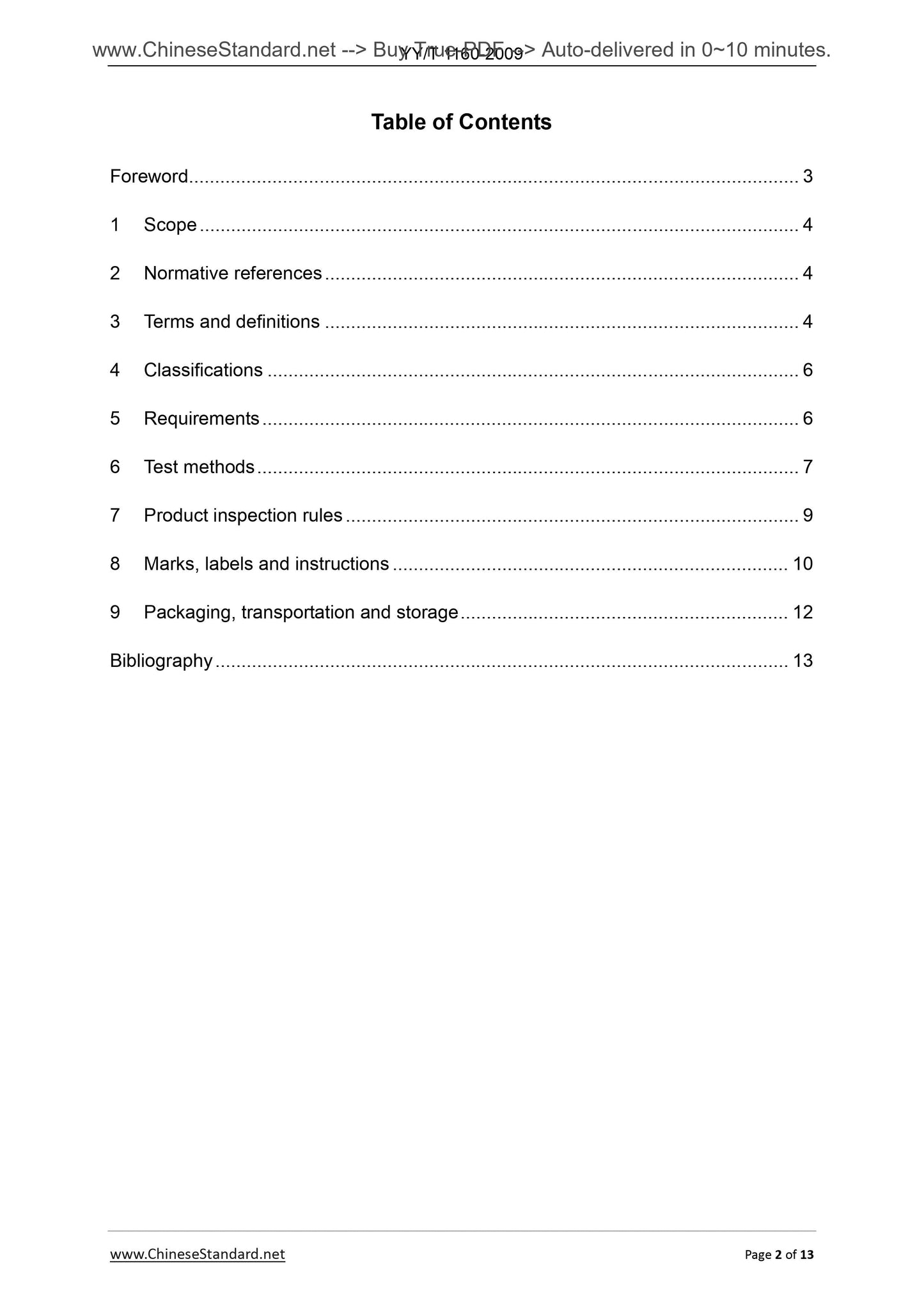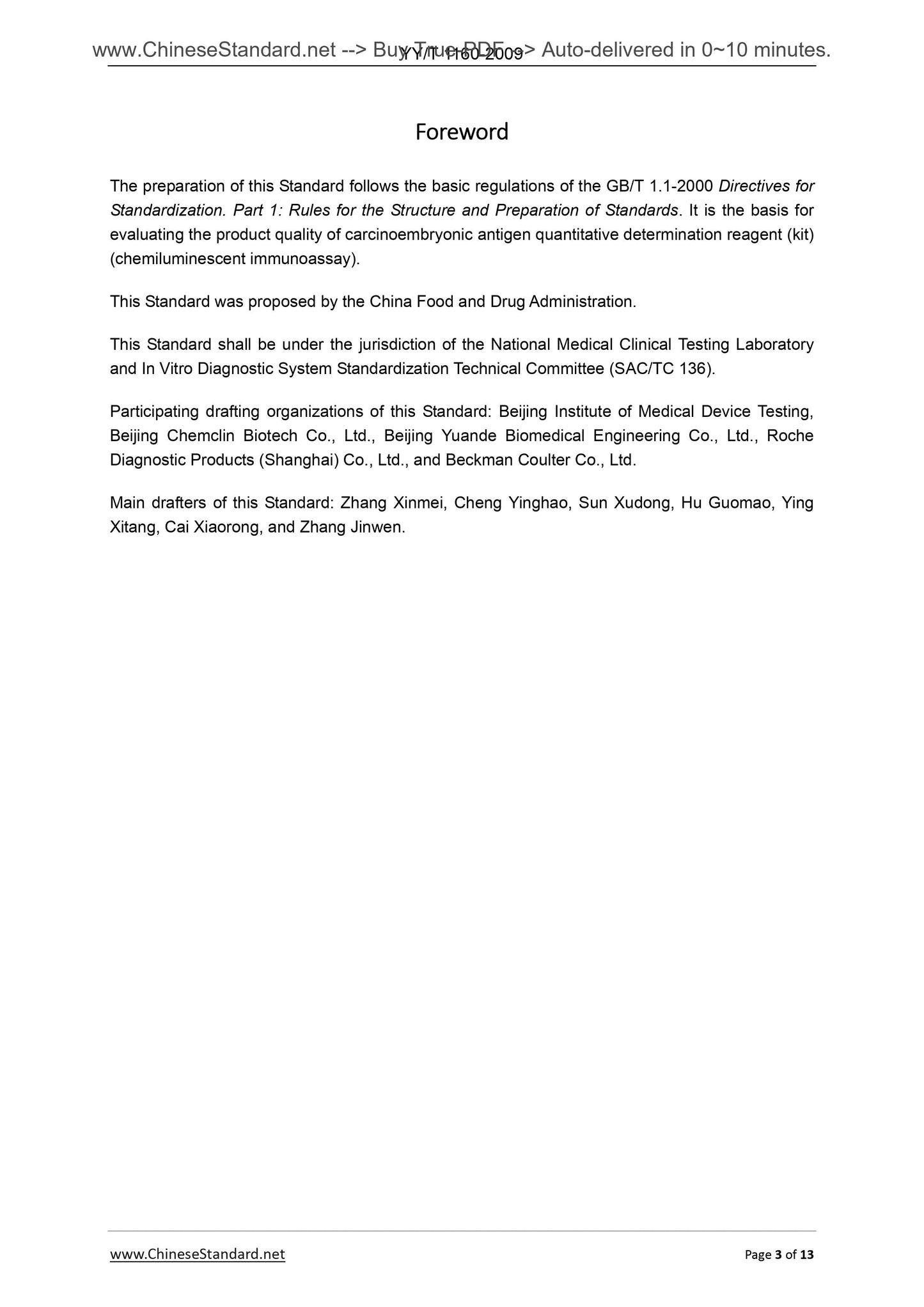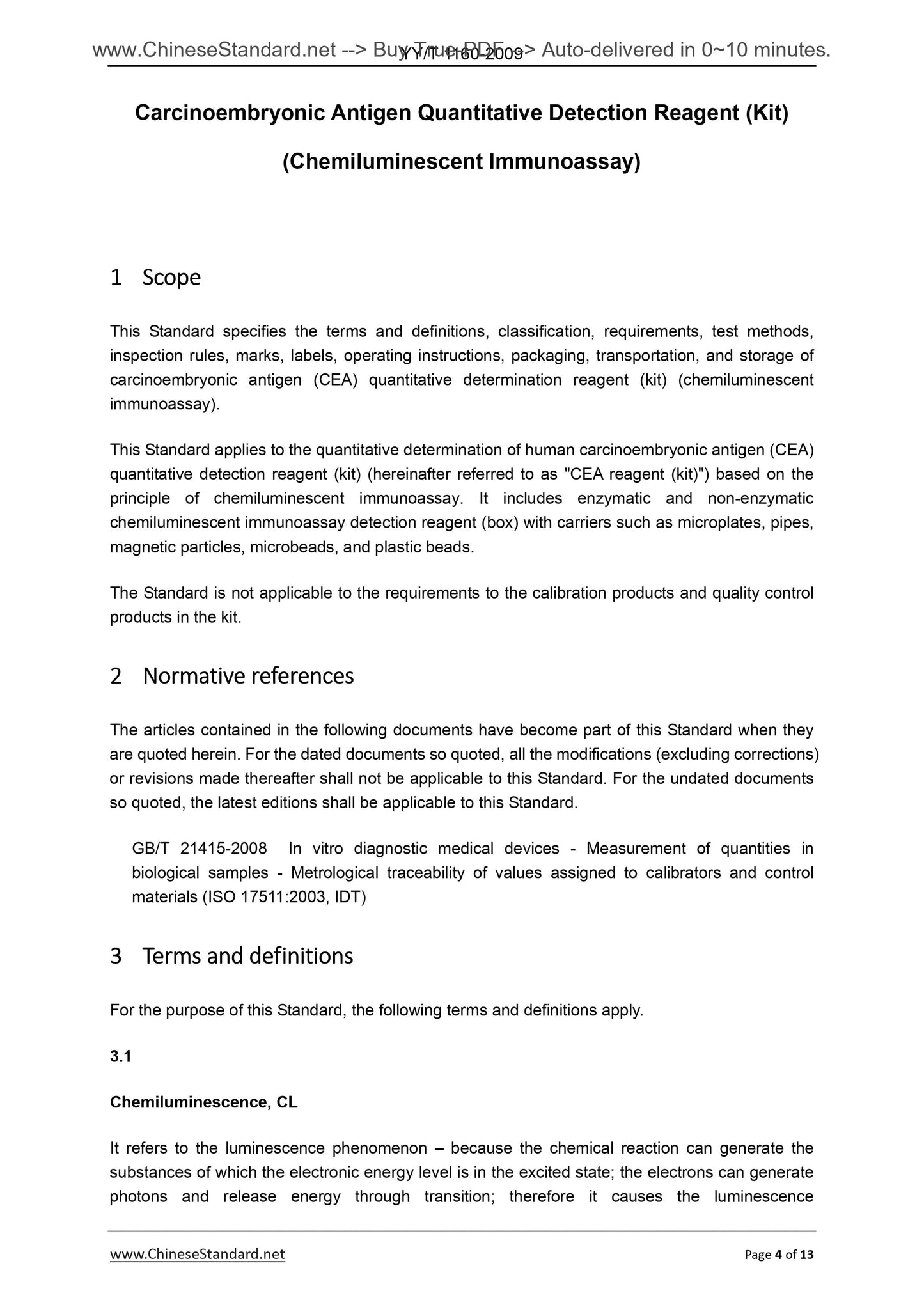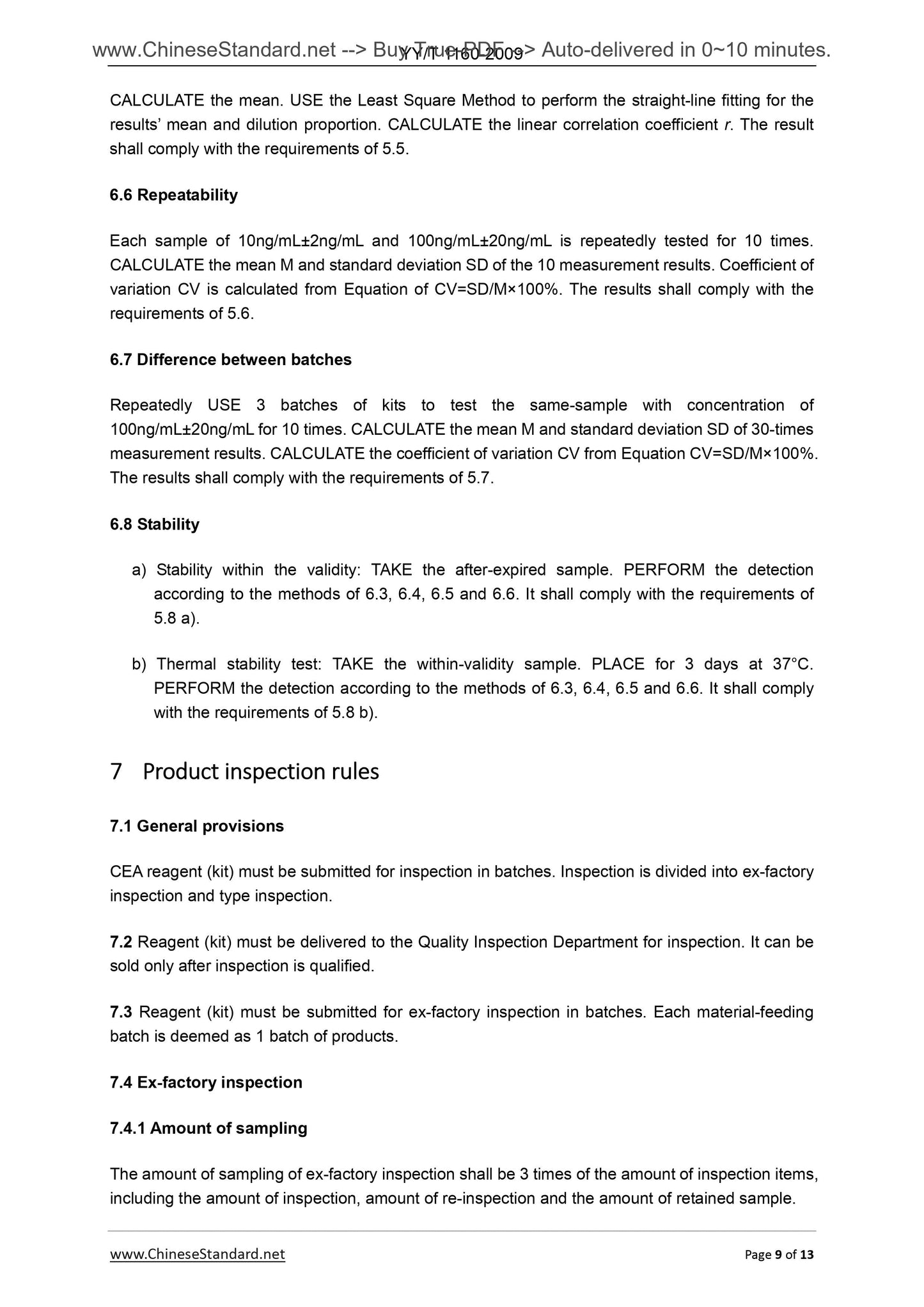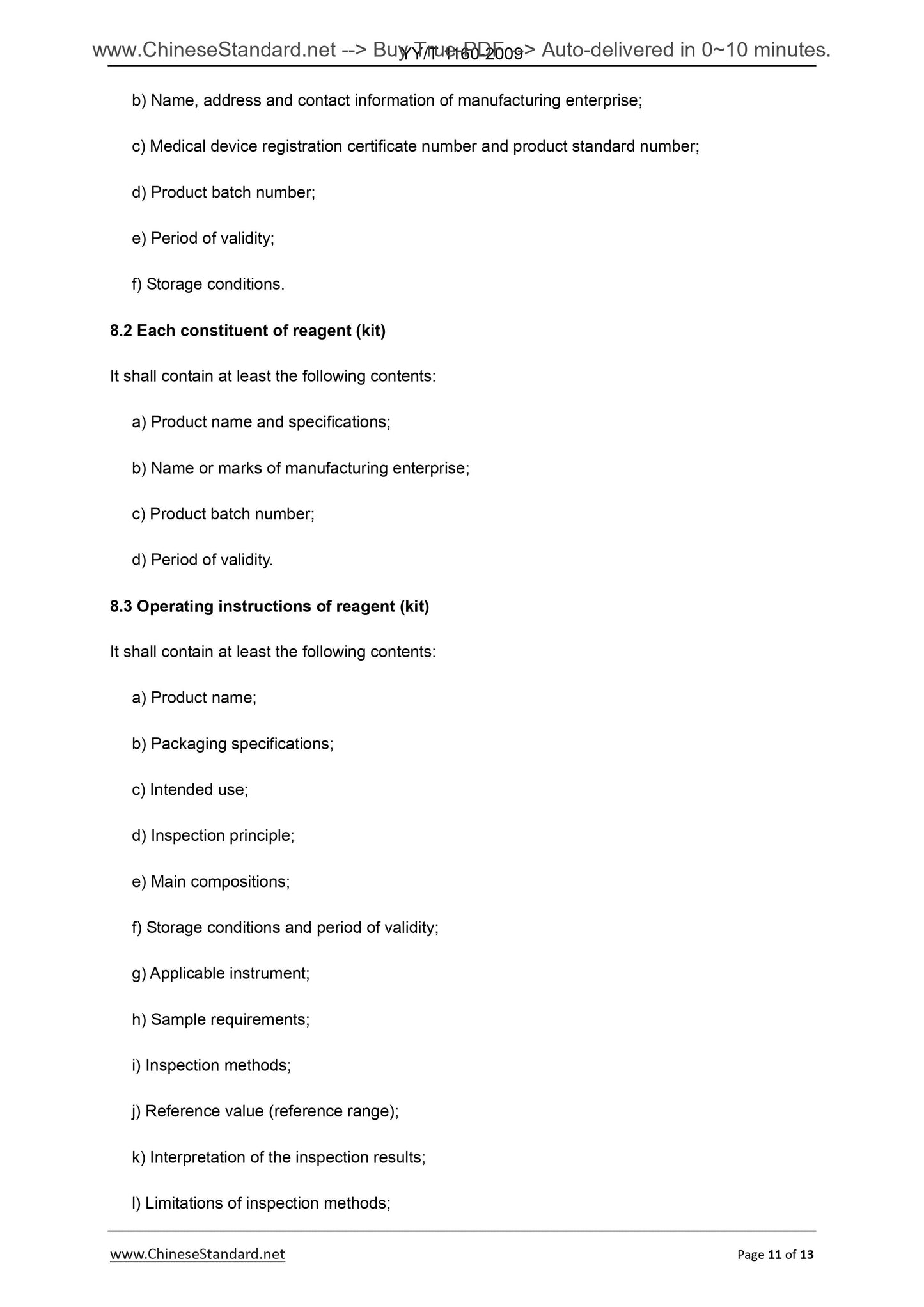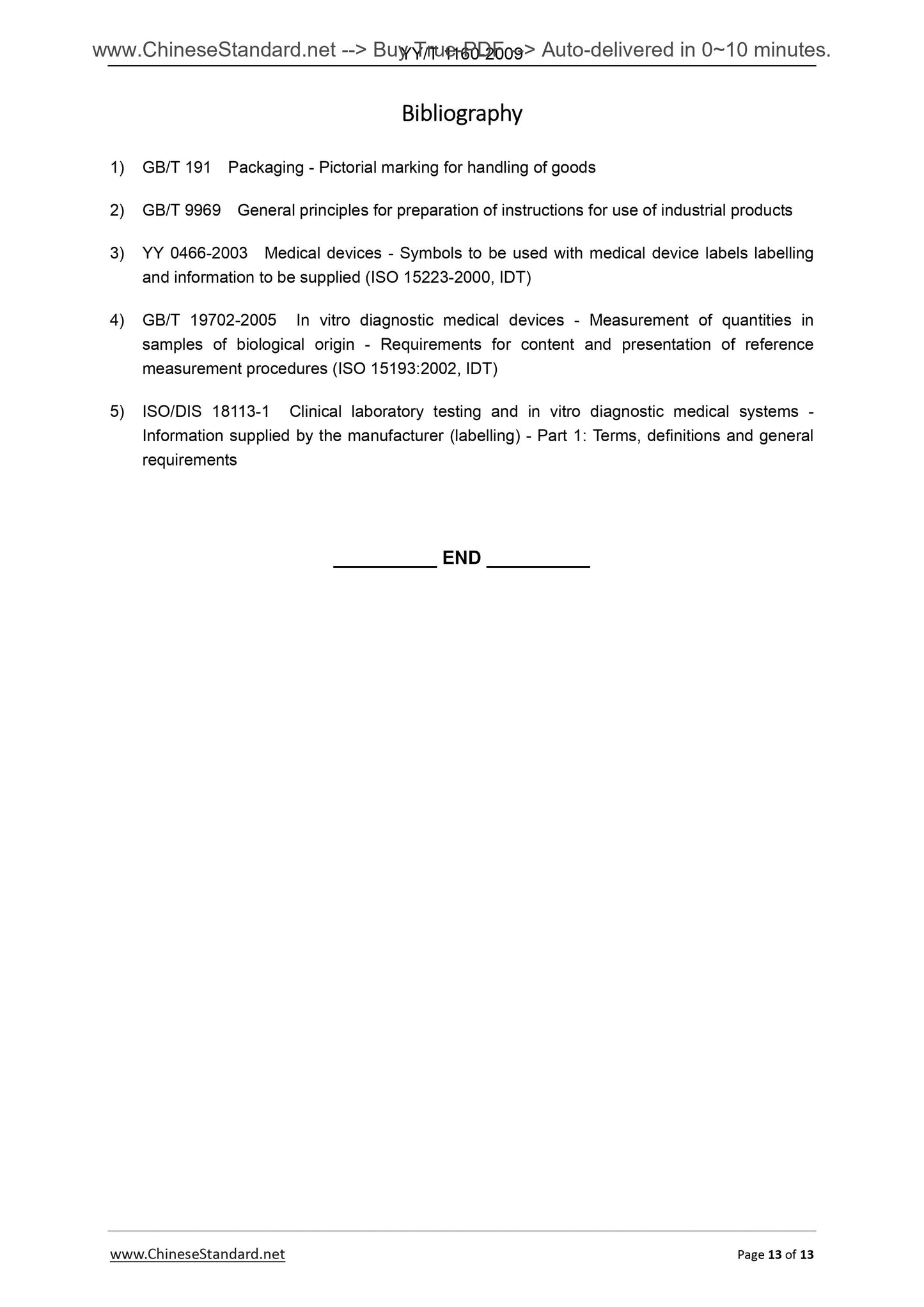PayPal, credit cards. Download editable-PDF & invoice in 1 second!
YY/T 1160-2009 English PDF (YYT1160-2009)
YY/T 1160-2009 English PDF (YYT1160-2009)
Precio habitual
$135.00 USD
Precio habitual
Precio de oferta
$135.00 USD
Precio unitario
/
por
Los gastos de envío se calculan en la pantalla de pago.
No se pudo cargar la disponibilidad de retiro
Delivery: 3 seconds. Download true-PDF + Invoice.
Get QUOTATION in 1-minute: Click YY/T 1160-2009
Historical versions: YY/T 1160-2009
Preview True-PDF (Reload/Scroll if blank)
YY/T 1160-2009: Carcinoembryonic Antigen Quantitative Detection Reagent (Kit) (Chemiluminescent Immunoassay)
YY/T 1160-2009
YY
ICS 11.100
C 44
PHARMACEUTICAL INDUSTRY STANDARD
OF THE PEOPLE’S REPUBLIC OF CHINA
Carcinoembryonic Antigen Quantitative Detection
Reagent (Kit)
(Chemiluminescent Immunoassay)
ISSUED ON. DECEMBER 30, 2009
IMPLEMENTED ON. JUNE 1,2011
Issued by. State Food and Drug Administration
Table of Contents
Foreword ... 3
1 Scope ... 4
2 Normative references ... 4
3 Terms and definitions ... 4
4 Classifications ... 6
5 Requirements ... 6
6 Test methods ... 7
7 Product inspection rules ... 9
8 Marks, labels and instructions ... 10
9 Packaging, transportation and storage ... 12
Bibliography ... 13
Foreword
The preparation of this Standard follows the basic regulations of the GB/T 1.1-2000 Directives for
Standardization. Part 1. Rules for the Structure and Preparation of Standards. It is the basis for
evaluating the product quality of carcinoembryonic antigen quantitative determination reagent (kit)
(chemiluminescent immunoassay).
This Standard was proposed by the China Food and Drug Administration.
This Standard shall be under the jurisdiction of the National Medical Clinical Testing Laboratory
and In Vitro Diagnostic System Standardization Technical Committee (SAC/TC 136).
Participating drafting organizations of this Standard. Beijing Institute of Medical Device Testing,
Beijing Chemclin Biotech Co., Ltd., Beijing Yuande Biomedical Engineering Co., Ltd., Roche
Diagnostic Products (Shanghai) Co., Ltd., and Beckman Coulter Co., Ltd.
Main drafters of this Standard. Zhang Xinmei, Cheng Yinghao, Sun Xudong, Hu Guomao, Ying
Xitang, Cai Xiaorong, and Zhang Jinwen.
Carcinoembryonic Antigen Quantitative Detection Reagent (Kit)
(Chemiluminescent Immunoassay)
1 Scope
This Standard specifies the terms and definitions, classification, requirements, test methods,
inspection rules, marks, labels, operating instructions, packaging, transportation, and storage of
carcinoembryonic antigen (CEA) quantitative determination reagent (kit) (chemiluminescent
immunoassay).
This Standard applies to the quantitative determination of human carcinoembryonic antigen (CEA)
quantitative detection reagent (kit) (hereinafter referred to as "CEA reagent (kit)") based on the
principle of chemiluminescent immunoassay. It includes enzymatic and non-enzymatic
chemiluminescent immunoassay detection reagent (box) with carriers such as microplates, pipes,
magnetic particles, microbeads, and plastic beads.
The Standard is not applicable to the requirements to the calibration products and quality control
products in the kit.
2 Normative references
The articles contained in the following documents have become part of this Standard when they
are quoted herein. For the dated documents so quoted, all the modifications (excluding corrections)
or revisions made thereafter shall not be applicable to this Standard. For the undated documents
so quoted, the latest editions shall be applicable to this Standard.
GB/T 21415-2008 In vitro diagnostic medical devices - Measurement of quantities in
biological samples - Metrological traceability of values assigned to calibrators and control
materials (ISO 17511.2003, IDT)
3 Terms and definitions
For the purpose of this Standard, the following terms and definitions apply.
3.1
Chemiluminescence, CL
It refers to the luminescence phenomenon – because the chemical reaction can generate the
substances of which the electronic energy level is in the excited state; the electrons can generate
photons and release energy through transition; therefore it causes the luminescence
CALCULATE the mean. USE the Least Square Method to perform the straight-line fitting for the
results’ mean and dilution proportion. CALCULATE the linear correlation coefficient r. The result
shall comply with the requirements of 5.5.
6.6 Repeatability
Each sample of 10ng/mL±2ng/mL and 100ng/mL±20ng/mL is repeatedly tested for 10 times.
CALCULATE the mean M and standard deviation SD of the 10 measurement results. Coefficient of
variation CV is calculated from Equation of CV=SD/M×100%. The results shall comply with the
requirements of 5.6.
6.7 Difference between batches
Repeatedly USE 3 batches of kits to test the same-sample with concentration of
100ng/mL±20ng/mL for 10 times. CALCULATE the mean M and standard deviation SD of 30-times
measurement results. CALCULATE the coefficient of variation CV from Equation CV=SD/M×100%.
The results shall comply with the requirements of 5.7.
6.8 Stability
a) Stability within the validity. TAKE the after-expired sample. PERFORM the detection
according to the methods of 6.3, 6.4, 6.5 and 6.6. It shall comply with the requirements of
5.8 a).
b) Thermal stability test. TAKE the within-validity sample. PLACE for 3 days at 37°C.
PERFORM the detection according to the methods of 6.3, 6.4, 6.5 and 6.6. It shall comply
with the requirements of 5.8 b).
7 Product inspection rules
7.1 General provisions
CEA reagent (kit) must be submitted for inspection in batches. Inspection is divided into ex-factory
inspection and type inspection.
7.2 Reagent (kit) must be delivered to the Quality Inspection Department for inspection. It can be
sold only after inspection is qualified.
7.3 Reagent (kit) must be submitted for ex-factory inspection in batches. Each material-feeding
batch is deemed as 1 batch of products.
7.4 Ex-factory inspection
7.4.1 Amount of sampling
The amount of sampling of ex-factory inspection shall be 3 times of the amount of inspection items,
including the amount of inspection, amount of re-inspection and the amount of retained sample.
b) Name, address and contact information of manufacturing enterprise;
c) Medical device registration certificate number and product standard number;
d) Product batch number;
e) Period of validity;
f) Storage conditions.
8.2 Each constituent of reagent (kit)
It shall contain at least the following contents.
a) Product name and specifications;
b) Name or marks of manufacturing enterprise;
c) Product batch number;
d) Period of validity.
8.3 Operating instructions of reagent (kit)
It shall contain at least the following contents.
a) Product name;
b) Packaging specifications;
c) Intended use;
d) Inspection principle;
e) Main compositions;
f) Storage conditions and period of validity;
g) Applicable instrument;
h) Sample requirements;
i) Inspection methods;
j) Reference value (reference range);
k) Interpretation of the inspection results;
l) Limitations of inspection methods;
Bibliography
1) GB/T 191 Packaging - Pictorial marking for handling of goods
2) GB/T 9969 General principles for preparation of instructions for use of industrial products
3) YY 0466-2003 Medical devices - Symbols to be used with medical device labels labelling
and information to be supplied (ISO 15223-2000, IDT)
4) GB/T 19702-2005 In vitro diagnostic medical devices - Measurement of quantities in
samples of biological origin - Requirements for content and presentation of reference
measurement procedures (ISO 15193.2002, IDT)
5) ISO/DIS 18113-1 Clinical laboratory testing and in vitro diagnostic medical systems -
Information supplied by the manufacturer (labelling) - Part 1. Terms, definitions and general
requirements
Get QUOTATION in 1-minute: Click YY/T 1160-2009
Historical versions: YY/T 1160-2009
Preview True-PDF (Reload/Scroll if blank)
YY/T 1160-2009: Carcinoembryonic Antigen Quantitative Detection Reagent (Kit) (Chemiluminescent Immunoassay)
YY/T 1160-2009
YY
ICS 11.100
C 44
PHARMACEUTICAL INDUSTRY STANDARD
OF THE PEOPLE’S REPUBLIC OF CHINA
Carcinoembryonic Antigen Quantitative Detection
Reagent (Kit)
(Chemiluminescent Immunoassay)
ISSUED ON. DECEMBER 30, 2009
IMPLEMENTED ON. JUNE 1,2011
Issued by. State Food and Drug Administration
Table of Contents
Foreword ... 3
1 Scope ... 4
2 Normative references ... 4
3 Terms and definitions ... 4
4 Classifications ... 6
5 Requirements ... 6
6 Test methods ... 7
7 Product inspection rules ... 9
8 Marks, labels and instructions ... 10
9 Packaging, transportation and storage ... 12
Bibliography ... 13
Foreword
The preparation of this Standard follows the basic regulations of the GB/T 1.1-2000 Directives for
Standardization. Part 1. Rules for the Structure and Preparation of Standards. It is the basis for
evaluating the product quality of carcinoembryonic antigen quantitative determination reagent (kit)
(chemiluminescent immunoassay).
This Standard was proposed by the China Food and Drug Administration.
This Standard shall be under the jurisdiction of the National Medical Clinical Testing Laboratory
and In Vitro Diagnostic System Standardization Technical Committee (SAC/TC 136).
Participating drafting organizations of this Standard. Beijing Institute of Medical Device Testing,
Beijing Chemclin Biotech Co., Ltd., Beijing Yuande Biomedical Engineering Co., Ltd., Roche
Diagnostic Products (Shanghai) Co., Ltd., and Beckman Coulter Co., Ltd.
Main drafters of this Standard. Zhang Xinmei, Cheng Yinghao, Sun Xudong, Hu Guomao, Ying
Xitang, Cai Xiaorong, and Zhang Jinwen.
Carcinoembryonic Antigen Quantitative Detection Reagent (Kit)
(Chemiluminescent Immunoassay)
1 Scope
This Standard specifies the terms and definitions, classification, requirements, test methods,
inspection rules, marks, labels, operating instructions, packaging, transportation, and storage of
carcinoembryonic antigen (CEA) quantitative determination reagent (kit) (chemiluminescent
immunoassay).
This Standard applies to the quantitative determination of human carcinoembryonic antigen (CEA)
quantitative detection reagent (kit) (hereinafter referred to as "CEA reagent (kit)") based on the
principle of chemiluminescent immunoassay. It includes enzymatic and non-enzymatic
chemiluminescent immunoassay detection reagent (box) with carriers such as microplates, pipes,
magnetic particles, microbeads, and plastic beads.
The Standard is not applicable to the requirements to the calibration products and quality control
products in the kit.
2 Normative references
The articles contained in the following documents have become part of this Standard when they
are quoted herein. For the dated documents so quoted, all the modifications (excluding corrections)
or revisions made thereafter shall not be applicable to this Standard. For the undated documents
so quoted, the latest editions shall be applicable to this Standard.
GB/T 21415-2008 In vitro diagnostic medical devices - Measurement of quantities in
biological samples - Metrological traceability of values assigned to calibrators and control
materials (ISO 17511.2003, IDT)
3 Terms and definitions
For the purpose of this Standard, the following terms and definitions apply.
3.1
Chemiluminescence, CL
It refers to the luminescence phenomenon – because the chemical reaction can generate the
substances of which the electronic energy level is in the excited state; the electrons can generate
photons and release energy through transition; therefore it causes the luminescence
CALCULATE the mean. USE the Least Square Method to perform the straight-line fitting for the
results’ mean and dilution proportion. CALCULATE the linear correlation coefficient r. The result
shall comply with the requirements of 5.5.
6.6 Repeatability
Each sample of 10ng/mL±2ng/mL and 100ng/mL±20ng/mL is repeatedly tested for 10 times.
CALCULATE the mean M and standard deviation SD of the 10 measurement results. Coefficient of
variation CV is calculated from Equation of CV=SD/M×100%. The results shall comply with the
requirements of 5.6.
6.7 Difference between batches
Repeatedly USE 3 batches of kits to test the same-sample with concentration of
100ng/mL±20ng/mL for 10 times. CALCULATE the mean M and standard deviation SD of 30-times
measurement results. CALCULATE the coefficient of variation CV from Equation CV=SD/M×100%.
The results shall comply with the requirements of 5.7.
6.8 Stability
a) Stability within the validity. TAKE the after-expired sample. PERFORM the detection
according to the methods of 6.3, 6.4, 6.5 and 6.6. It shall comply with the requirements of
5.8 a).
b) Thermal stability test. TAKE the within-validity sample. PLACE for 3 days at 37°C.
PERFORM the detection according to the methods of 6.3, 6.4, 6.5 and 6.6. It shall comply
with the requirements of 5.8 b).
7 Product inspection rules
7.1 General provisions
CEA reagent (kit) must be submitted for inspection in batches. Inspection is divided into ex-factory
inspection and type inspection.
7.2 Reagent (kit) must be delivered to the Quality Inspection Department for inspection. It can be
sold only after inspection is qualified.
7.3 Reagent (kit) must be submitted for ex-factory inspection in batches. Each material-feeding
batch is deemed as 1 batch of products.
7.4 Ex-factory inspection
7.4.1 Amount of sampling
The amount of sampling of ex-factory inspection shall be 3 times of the amount of inspection items,
including the amount of inspection, amount of re-inspection and the amount of retained sample.
b) Name, address and contact information of manufacturing enterprise;
c) Medical device registration certificate number and product standard number;
d) Product batch number;
e) Period of validity;
f) Storage conditions.
8.2 Each constituent of reagent (kit)
It shall contain at least the following contents.
a) Product name and specifications;
b) Name or marks of manufacturing enterprise;
c) Product batch number;
d) Period of validity.
8.3 Operating instructions of reagent (kit)
It shall contain at least the following contents.
a) Product name;
b) Packaging specifications;
c) Intended use;
d) Inspection principle;
e) Main compositions;
f) Storage conditions and period of validity;
g) Applicable instrument;
h) Sample requirements;
i) Inspection methods;
j) Reference value (reference range);
k) Interpretation of the inspection results;
l) Limitations of inspection methods;
Bibliography
1) GB/T 191 Packaging - Pictorial marking for handling of goods
2) GB/T 9969 General principles for preparation of instructions for use of industrial products
3) YY 0466-2003 Medical devices - Symbols to be used with medical device labels labelling
and information to be supplied (ISO 15223-2000, IDT)
4) GB/T 19702-2005 In vitro diagnostic medical devices - Measurement of quantities in
samples of biological origin - Requirements for content and presentation of reference
measurement procedures (ISO 15193.2002, IDT)
5) ISO/DIS 18113-1 Clinical laboratory testing and in vitro diagnostic medical systems -
Information supplied by the manufacturer (labelling) - Part 1. Terms, definitions and general
requirements
Share
